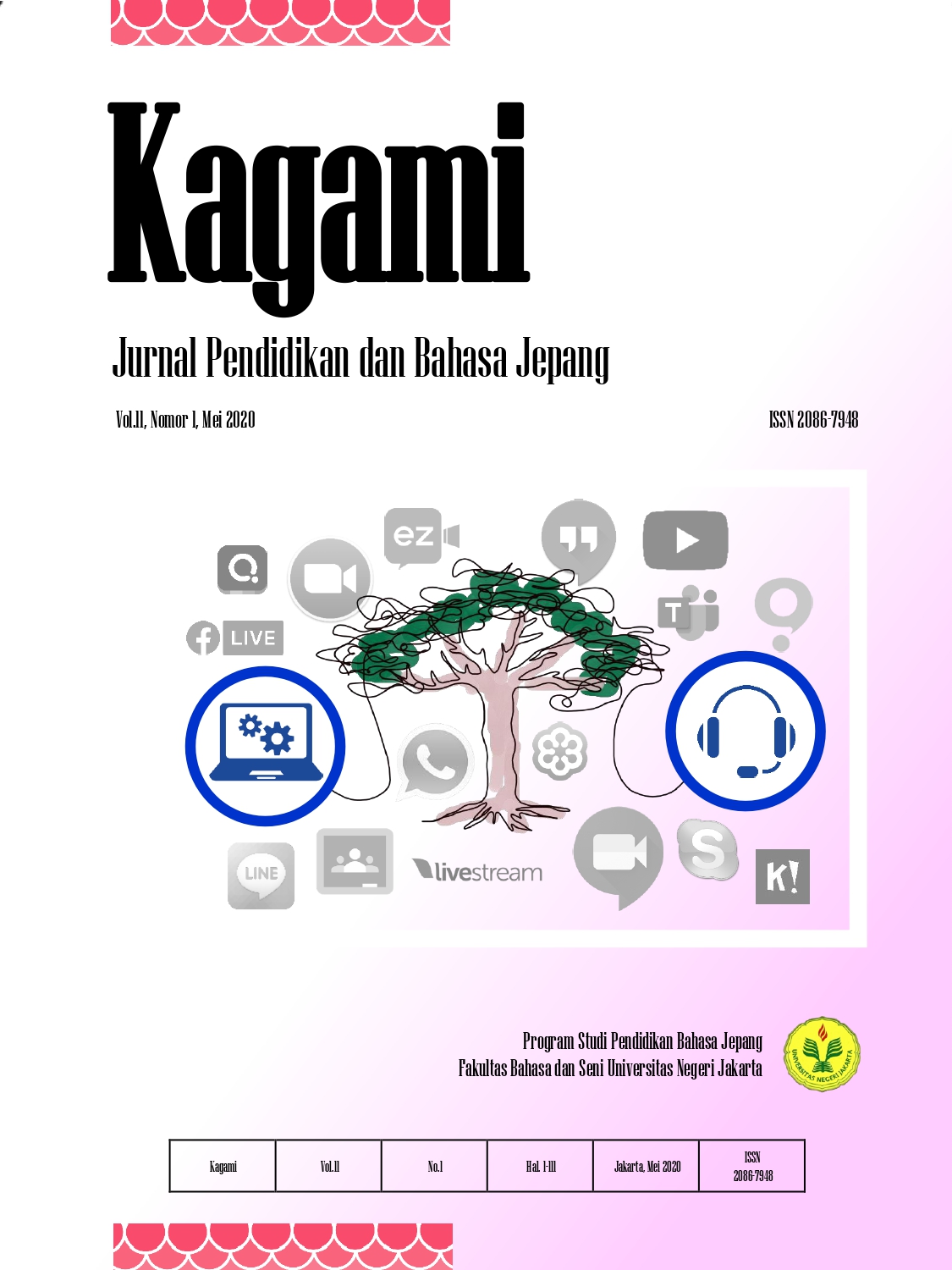Sufiks Pemarkah Kanji Profesi dalam Bahasa Jepang
Keywords:
suffix, kanji profession, meaningAbstract
This research aims to describe the meaning of suffixes attached to kanji profession in
Japanese which have different suffixes but the same meaning. Theories used in this
research are morphology and semantics. This research is a qualitative research. The data
collection technique used in this research is literature study. The data analysis technique
used is the determining element. The data in this research are in the form of kanji
profession which have the same meaning but different suffixes. Data collected in the form
of kanji profession means doctors, teachers, writers and painters. The data source used is
dictionary entitled Japanese dictionary by Pristian Wulanita (Team I-Smart University).
The result of this research describes the different meaning of the data collected and 医師
ishi is used in more formal situation than 医者isha. 医家ika is an ancient vocabulary
which shows that the profession of doctor is the hereditary from his family. 教 師 kyoushi
is used not only for a teacher who teaches certain subjects in school, but also can used in
other teaching contexts. 教員kyouin means a teacher who educates students at school. 作家
sakka becomes more specific as a novelist and 作 者 sakusha is a writer of more general
works of art such as manga, anime, picture books, drama scripts. 画 家 gaka has the
specific meaning of a painter, while 画師 eshi 絵師 eshi means an illustrator.
References
Jepang. Tugas Akhir Diploma III. Universitas Sumatera Utara. Dalam
repository usu, diakses dari https://repository.usu.ac.id/ pada tanggal 2 April
2018 pukul 19.00 WIB.
Azwar, Saifuddin. 2004. Metode Penelitian. Yogyakarta: Pustaka Pelajar.
Chaer, Abdul. 2015. Morfologi Bahasa Indonesia (Pendekatan Proses). Jakarta:
PT Rineke Cipta.
Hatasa, Yukiko Abe, dkk. 2011. Nakama 1: Introductory Japanese:
Communication, Culture, Context, Second Edition. USA: Heinle, Cengage
Learning.
46
Hirose, Hitoshi. 1996. Functions of Graphemic Components of Kanji on
Recognition of Jukugo. Jurnal. Dalam jurnal Hiroshima Forum for
Psychology, diakses dari e-resources.perpusnas.go.id Diakses 27 Februari
2019 pukul 19.10 WIB.
Iori, Isao, dkk. 2004. Chuujoukyuu O Oshieru Hito No Tame No Nihongo Bunpou
Handobukku. Tokyo: Takaseidouhaku.
Isfiyah, A. 2016. Analisis Bentuk dan Makna Sufiks ~ 者Sha, ~員 In, ~士 Shi
dalam Koran Bahasa Jepang Tahun 2016. Jurnal. Pendidikan Bahasa Jepang.
Surabaya. Universitas Negeri Surabaya. Dalam jurnal mahasiswa unesa,
diakses dari http://jurnalmahasiswa.unesa.ac.id Diakses 2 April 2018 pukul
19.30 WIB.
Kesuma, Jati. 2007. Pengantar (Metode) Penelitian Bahasa. Yogyakarta:
Carasvatibooks.
Parera, J.D. 2004. Teori Semantik. Jakarta: Erlangga.
Puska, R. Tandai. 2017. Sufiks Penanda Profesi Bahasa Jepang. Skrisi.
Universitas Diponegoro. Dalam eprints undip, diakses dari
http://eprints.undip.ac.id/58389/ pada tanggal 10 April 2018 pukul 19.00 WIB.
Sutedi, Dedi. 2011. Dasar-dasar Linguistik Bahasa Jepang. Bandung: Humaniora.
Weblio, Inc. 2005. Tokyo. https://www.weblio.jp/ Diakses pada tanggal 3 April
2020 pukul 10.30 WIB.





